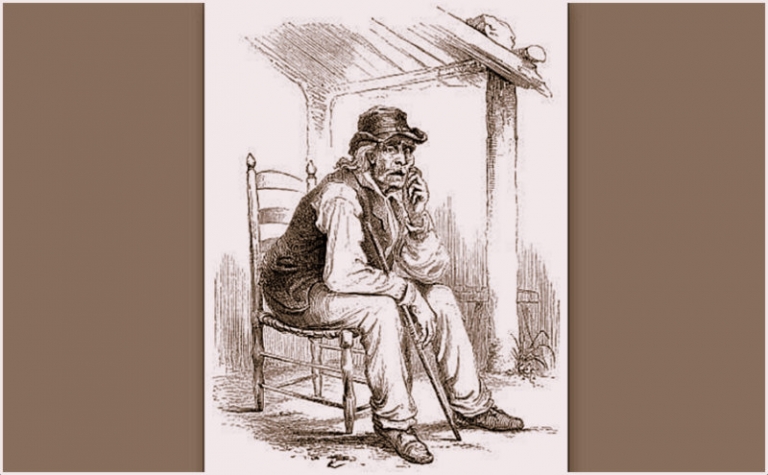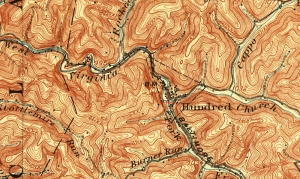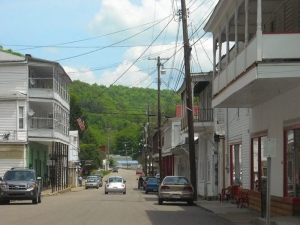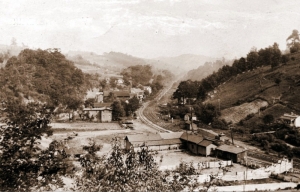
HUNDRED, W.Va. — There was a time soon after the completion of the B&O Railroad when passengers would clamber to the car windows to catch a glimpse of "Old Hundred." He was a marvel of a man who, even after his hundredth birthday, labored in his fields to the delight of passersby.
The town of Hundred (population 299 as of 2010) was named for that man, Henry Church.
The community remains the lone bearer of that name, and travelers on US-250 — bound through the hills from Fairmont or Morgantown in the east to Moundsville or New Martinsville in the west — are often interested in knowing something of its origin.

Church, as he was known for the first 99 years of his life, was born in Suffolk, in the westernmost part of England, in 1750, though he died on September 14, 1860, here at Hundred on the upper section of the "West Virginia Fork of Fish Creek" at the confluence of what's now Church Fork.
According to his tombstone, located on the hill above the town in the Hundred Cemetery, he was 109 years, nine months, and one day old when he passed.
According to most accounts, Church was a member of the bodyguard of King George III, and Church and a friend, John Taylor, also of the guard, were among several young men sent to the colonies to serve under Lord Charles, Earl Cornwallis, in the 63rd British Light Infantry.
Before the campaign at Yorktown, which ended the Revolutionary War, Church was sent out on a scouting party and, somewhere between Richmond and Petersburg, was taken prisoner by troops under the command of the Marquis de Lafayette. He was bound and transported to Camp Chase, near Lancaster, Pennsylvania, where he was imprisoned until peace was declared.
Rather than return to England after his release, however, he decided to remain in America and, at about that time, met Hannah Keline, a Quaker girl born in Philadelphia in about 1755. The two married and soon embarked on a long and exciting life.
After the wedding, the couple visited Keline's brother, who lived in the Shenandoah Valley. From there, they started westward, following an Indian trail over the Allegheny Mountains, down the Monongahela River, and up Dunkard Creek to the mouth of Indian Run, now called Wise Run, in present-day Monongalia County near Wadestown. Here, at what was known as Indian Meadow, they raised a cabin, cleared the land, and registered it in Morgantown as the Church-Keline Improvement.

Soon thereafter, the Churches moved 10 miles westward to the West Virginia Fork of Fish Creek in Wetzel County, where they again built a cabin and cleared the land. Though it had been claimed as a tomahawk right by a George Garrison (meaning that Garrison had girded several trees to establish a claim, which was generally honored by settlers though it was not enforceable in a court), Church traded Garrison a flintlock rifle for the claim. The Bank of Hundred now stands where the cabin once stood.
According to Ethel Briggs, who became a foremost authority on the family, life for the Churches never grew less interesting.
"They were well-liked by everybody. Being honest, hard-working people, they won the respect and admiration of the community far and wide. He was a patriotic old gent, and at the time of the War of 1812, he was drafted by the government.
"He was proud of the fact, shouldered his rifle, and started off to the front to fight on the colonists' side to fight his beloved England, although he had refused to take the oath of allegiance to the American Colonists. All Englishmen required this oath at the close of the Revolutionary War.
"He gave his reason for refusing to sign: that he had sworn to be true to King George of England. However, later, when he wanted to sell a part of his land, he learned this could not be done unless he signed the oath, which he did in about 1850."
As for his service in the War of 1812, Briggs wrote that "it seems travel was slow, and peace was declared before he got very far from home, so he returned home and never had a chance to show his spirit for America again."
In 1852, when Church was 102, the Baltimore and Ohio Railroad opened, using the upper valley of Fish Creek as part of its passage across the mountains. Railroad officials were told of the Churches and excitedly offered them an observation car to take them to Wheeling.
Church answered, saying they had never made a show of themselves and refused to go. Railway officials were just as stubborn; thereafter, train conductors were instructed to point out the old couple to passengers as they passed through Hundred.
"Henry and Hannah could be seen any nice day sitting on the porch of their log cabin," Briggs wrote. "Often, Henry would be sighted mowing in the fields with a scythe. They were then the oldest couple in the state," which included all of Virginia, from the Atlantic to the Ohio River.
The Churches lived together for 82 years and raised eight children, all of whom enjoyed long lives, though not as long as their parents. Mrs. Church died on July 27, 1860, and Mr. Church followed her less than two months later.
Little girl saved train on the little-known Short Line in 1902

Each year, Pine Grove hosts the Shortline Ramp Festival, the celebration of the native "ramp," or wild leek, and the event is accounted among the best of such festivals in the state. Perhaps as importantly, it celebrates the West Virginia Short Line Railroad. This lesser-known, 60-mile rail line opened from Clarksburg, in the Monongahela Valley, to New Martinsville, on the Ohio River, in 1902. READ THE FULL STORY HERE.
Sign up for a FREE copy of West Virginia Explorer Magazine in your weekly email. Sign me up!






























